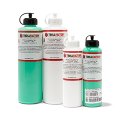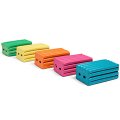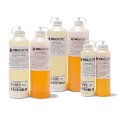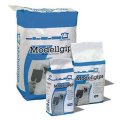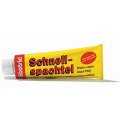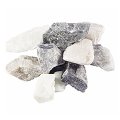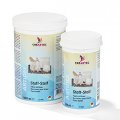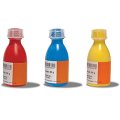Epoxy Casting Resins
Properties and application of epoxy casting resins
Attributes and applications: Like polyester casting resins, epoxy resins belong to the “duroplasts”, i.e., the group of plastics that, having once hardened, will never be able to revert back to a malleable state, as is the case with thermoplastics. In cases where simple, transparent and colourless casting work is to be done, polyester resins can serve as a good alternative to epoxy resins because they do not exhibit any colour undertone. If, however, your work requires a greater degree of solidity and/or permanence, epoxy is much better than polyester. Epoxy resin is also temperature resistant in its own special way: if the temperature sinks (including far below zero), the resin tends to become even firmer and its tensile strength, compressive strength and bending strength increase as well. In addition, as far as dimensional stability is concerned, it performs wonderfully because it exhibits much less shrinkage during curing (in contrast to polyester). Further advantages include its durability, its excellent dielectric qualities (insulation), its outstanding (for a plastic) resistance to chemicals as well as its ability to withstand the effects of weathering. Epoxy resin, then, is “hard” in every way possible, which accounts for the wide spectrum of its uses:
- Epoxy resin is used as the matrix material in the production of fibre reinforced composites; thread-shaped fibres or ones that have been worked into a non-woven or non-crimp fabric (NCF) are embedded in the resin (lamination is one example).
- In combination with various other materials it is used in the production of basic but highly durable construction elements, for example in boat and vehicle construction, in the aviation and space travel sectors (very often) as well as more and more in architectural projects. What sets this technology apart is the possibility of designing extremely lightweight construction elements that satisfy specific and challenging structural demands – e.g., sailboat construction or producing gigantic and extremely economical aircraft and there are even plans for making bridges with spans of over 20 kilometres.
- Epoxy is used in the production of sandwich-type constructions with wood or foam cores – for example in model making (excellent adhesive properties of the material…).
- In a low viscosity form it is poured in order to cast construction elements.
- Electrical components and construction materials (e.g. cement) or other objects are poured/embedded or coated (including immersion processes) for purposes of insulation or protection against corrosion. Catchword: Gel coat - the application of a protective, very hard layer for sealing purposes.
- Epoxy resin functions as a bonding agent for loose materials like gravel in the production of durable flooring or ground covering.
- Epoxy resin is processed into liquid or doughy adhesives (see, for example, UHU Plus Endfest) that have many different applications.
Storage and Shelf Life: Both components can be stored for at least twelve months (actually much longer) if kept in their original closed containers at cool temperatures. At temperatures under 15 °C they can solidify somewhat and become cloudy, or, to be exact, they can crystallize. Before using them you will have to undo these changes by slowly warming up the bottles in warm water at about 60 °C (or by putting them in a microwave as follows: 30 seconds on medium, take out and check how hot it is. Shake the bottle. Repeat the process as necessary. Be careful.
Safety at work: Epoxy consists of two components; the resin itself is at the least an “irritant”, the hardener is usually categorized as “caustic”. Once cured, however, the material is completely harmless to your health. The unpleasantness of the odour when working with it is relatively mild – if you compare it to the pungent smell of styrene when working with polyester. You should nonetheless make sure that there is enough ventilation at your workstation and naturally avoid any contact with your skin or eyes – wearing GLOVES and SAFETY GOGGLES is highly recommended. In addition, please note that epoxy resin and its hardener should not be allowed to get into the plumbing, into bodies of water or in the soil. The best thing to do is allow whatever unused material you have to harden and dispose of the containers properly: hazardous materials depots are glad to accept resins and hardeners. Cured leftovers can be thrown away in your household or commercial garbage.
Treatment: It is important to note the following when working with epoxy resins: care must be taken that the resin and the hardener are mixed together thoroughly. You must also be precise when weighing the components because even a small deviation from the given ratio can negatively affect the attributes of the material after curing – it can be brittle, the surface might remain sticky, etc.
As is generally the case with casting compounds, the components should be mixed by weight in the proper ratio at room temperature (20-25 °C). If you add extra hardener it will not speed up the curing process but rather will negatively affect your results. The reverse is also true: if you use less hardener it will not increase the pot life. The amount of epoxy being used and the temperature it is being worked with are the primary determinates of pot life. Larger amounts shorten the pot life because of the heat that is produced during the (exothermic) curing process; smaller amounts (under 100 grams) have a somewhat longer working life. When the resin and hardener are at a higher temperature, the reaction time is speeded up, when at a lower temperature the pot life is increased. A general rule-of-thumb goes like this: For every 10-degree increase in heat, the pot life is cut in half.
After weighing the resin, the correspondingly proper amount of hardener should be stirred into the resin and the resulting mixture homogenized for at least two minutes (i.e., stirred A LOT). After the comprehensive mixing, the admixture should be allowed to sit for a while in order to allow any bubbles that may have developed in the brew to escape. The admixture is now ready to use or to be further processed (coloured, etc.) as required.
If the mixing ratio is correct and the components have been thoroughly mixed, the resin will be cross-linked (cured) to the tune of 90 %. An additional heat-curing step will once more increase the mechanical solidity and the resistance to heat. Taking this second curing step is only really necessary in cases of highly temperature resistant resins and in production of aviation components.
At this point we want to provide general tips for dealing with cold curing resins: In order to improve its attributes, an already cured material can be tempered for up to three hours at about 50 to 60 °C.
Cured epoxy resins can be further processed without any problems arising, i.e., sawn, drilled, sanded and polished.
One more thing: Our selection of epoxy resins will continue to grow. The addition of products for laminating systems that include special resins and non-woven and non-crimp (NCF) fabrics is in the planning stage. Once these plans are implemented, comprehensive instructions and tips pertaining to lamination processes and the like will be available.
